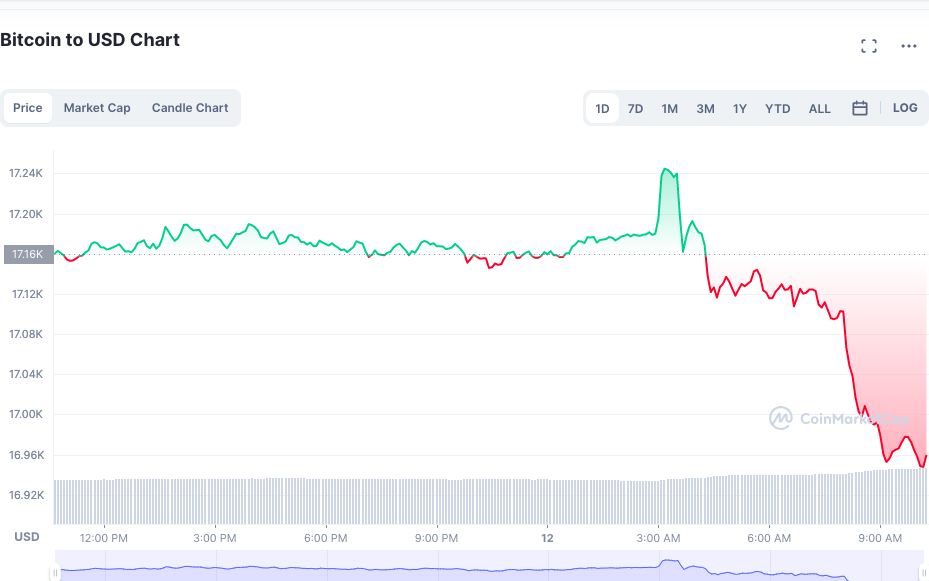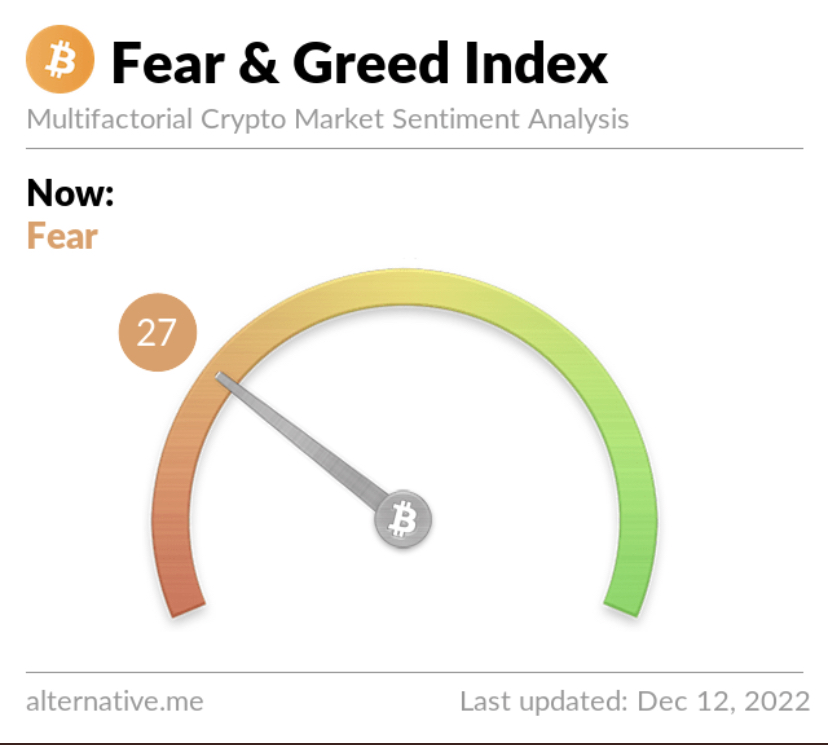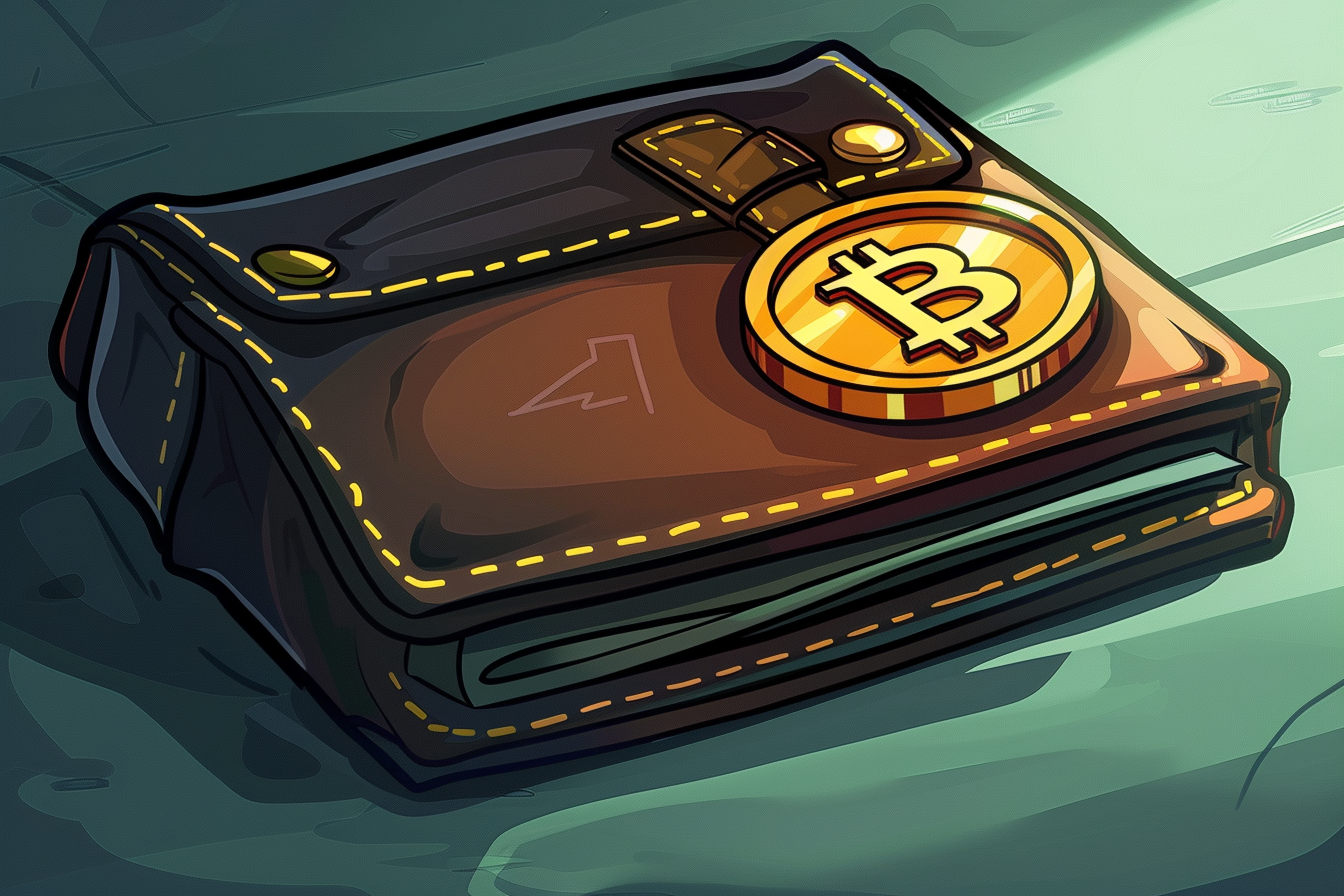Table of Contents
Bitcoin and other cryptocurrencies continued to loiter around previously recorded levels over the weekend, with the world’s largest cryptocurrency seemingly adopting a “sit and wait” stance as it looks towards Tuesday’s release of the CPI (Consumer Price Index) data in the United States.
At the time of writing, Bitcoin (BTC) is trading at US$16,911.74 (-1.44%), while Ethereum (ETH) is trading at US$1,247.27 (-1.88%). Major altcoins such as BNB, Avalanche (AVAX), and Polkadot (DOT) have also been trading in red within the same period.

While investors will be seeking answers from Tuesday’s CPI data and Thursday’s FOMC (Federal Open Market Committee) meeting, Federal Reserve chair Jerome Powell has previously indicated that a 50 bps rate hike is on the cards, which means that the market might already be priced in, despite recent reports of a hotter-than-expected labour market.
“A higher-than-expected CPI print and more hawkish Fed have the potential to invalidate this rally, like we saw in the April and August reversals. On the other hand, another disinflationary print could see many chase a continuation of the rally into year-end,” said QCP Capital in its latest note published over the weekend.
Meanwhile, former FTX CEO Sam Bankman-Fried has announced that he will be testifying at the US House Financial Services Committee hearing titled “Investigating the Collapse of FTX” on December 13. The Senate Banking Committee will also be holding a separate hearing the following day, but it remains unclear if Bankman-Fried will appear for that.
Related: Coinbase CEO Says “95% of Crypto People Are Legitimate” Despite “Massive FTX Fraud”
The outlook of crypto going into the new year remains unclear, especially when rumours of bankruptcy continue to swirl around key industry players like Amber Group and Genesis. But tis the season to be jolly, so instead of occupying yourselves with crypto’s less-than-merry year, put your feet up, have some ‘nog, and try not to think about that 70% (or even 100%) loss on your portfolio, as difficult as it may be.
Binance’s proof of reserves raises more questions than answers
A report by the Wall Street Journal (WSJ) has highlighted concerns about Binance’s release of its proof of reserves.
According to the report, which cited prominent figures in the finance industry, Binance’s report is less-than-satisfactory, and also contains a number of discrepancies.
For example, the report included a tweet by John Reed Stark, senior lecturing fellow at Duke University School of Law and former chief of the Securities Exchange Commission’s Office of Internet Enforcement, who said that the exchange’s report failed to address the “effectiveness of internal financial controls” and does not “express an opinion or assurance conclusion and doesn’t vouch for the numbers”.
“I worked at SEC Enforcement for 18+ yrs. This is how I define red flag,” Stark said.
On Wednesday, Binance released a five-page report from a partner at the South African affiliate of the global accounting firm Mazers, which did not show Binance’s total assets and liabilities – only the amount of bitcoin assets and bitcoin liabilities were revealed.
WSJ also highlighted the fact that there were differences between the total bitcoin liabilities, with the proof of reserves showing that Binance was 97% collateralized, excluding assets lended to users through loans or margin accounts, which means that the 1:1 ratio of reserves to customer assets was not actually achieved.
“We found that Binance was 97% collateralized without taking into account the Out-Of-Scope Assets pledged by customers as collateral for the In-Scope-Assets lent through the margin and loans service offering resulting in negative balances on the Customer Liability Report. With the inclusion of In-Scope Assets lent to customers through margin and loans which are overcollateralized by Out-Of-Scope Assets, we found that Binance was 101% collateralized,” Mazers explained in the report.
WSJ further noted that the report lacked basic information about Binance, including the name of the company’s ultimate parent company because according to Binance’s chief strategy officer Patrick Hillman, the company has been in the process of a broad corporate reorganization.
“We don’t know how good Binance’s systems are to liquidate assets to cover any margin loans,” Hal Schroeder, a former Financial Accounting Standards Board member and investment manager who teaches accounting at Rutgers University, told WSJ.
“And we know in the U.S., even with all the good systems, banks have occasionally been caught off-guard. In light of what we’ve seen in the Bahamas, I don’t want to conclude that all the systems are that good,” he added.
The report also included customers’ spot, options, margin, futures, funding, loan and earn accounts for Bitcoin and wrapped Bitcoin (WBTC). Aside from BTC, WBTC on Ethereum, BNB Chain and BNB Smart Chain were also included in Mazer’s enquiry. Binance has said that more information will be released in the future.
Do Kwon residing in Serbia?
An investigation by South Korean authorities has revealed that embattled Terraform Labs co-founder Do Kwon is likely to be residing in Serbia.
“Recently, we obtained intelligence that CEO Kwon was in Serbia, and it was found to be true,” an official told local media outlet Chosun.
The report also states that South Korea’s Ministry of Finance “is in the process of requesting cooperation from the Serbian government” as part of the investigation.
Related: “You’re Not Answering the Question”: Laura Shin Grills Do Kwon
In September, Interpol issued a Red Notice calling for law enforcement around the world to locate and arrest Kwon. South Korean officials have previously said that Kwon was residing in Singapore, a claim which was denied by Singaporean officials.
FTX secretly acquired The Block
According to a report by Axios, now-bankrupt FTX secretly funded media company The Block for over a year with money sent directly to CEO Michael McCaffrey.
The report, which cited sources familiar with the transactions, said that US$16 million batch of funding from Alameda was used in part to finance the purchase of an apartment in the Bahamas for McCaffrey.
McCaffrey has since stepped down from his role as CEO, and has been replaced by chief revenue officer Bobby Moran, who claimed that the news outlet’s employees were unaware of the transactions.
“No one at The Block had any knowledge of this financial arrangement besides Mike. From our own experience, we have seen no evidence that Mike ever sought to improperly influence the newsroom or research teams, particularly in their coverage of SBF, FTX, and Alameda Research,” said Moran.
Inner Mongolia police cracks down on blockchain money laundering ring
According to Chinese media, the Horqin Branch of Tongliao Public Security Bureau, Inner Mongolia Autonomous Region, has successfully busted a money laundering gang that reportedly used “the network blockchain” to launder roughly RMB12 billion (approximately US$1.8 billion).
The report stated that the police task force dispatched 230 police officers to 17 provinces, autonomous regions and municipalities including Heilongjiang, Guangdong, Beijing, and Henan to crack down on the gang. It will also be looking to arrest the main suspect, a man named Zhang Mou, which has reportedly fled to Bangkok, Thailand.
According to the report, 63 criminal suspects have been arrested thus far, and a total of about RMB130 million of criminal proceeds have been confiscated.
Trading Volume
According to data from CoinMarketCap, the global crypto market cap stands at US$845.66 billion, a 1.17% decrease since yesterday. The total crypto market volume over the last 24 hours is US$27.43 billion, a 15.28% increase.
Fear & Greed Index
Risk appetites are sapped – the Crypto Fear and Greed Index currently stands at 27, indicating “ fear” – a sign that investors are skittish. The index uses 5-6 measurements to assess the current sentiment of the market and then rates that level of emotion on a scale of 1-100 – 1 is extreme fear and 100 is extreme greed.
Sentiment climbed to reach 40 on 6 November, but it has remained in the low to mid 20s for the past month.







